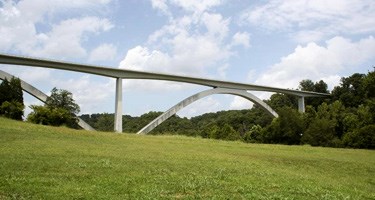Last updated: November 5, 2018
Article
Natchez Trace Parkway Road Reconstruction

NPS photo
The Natchez Trace Parkway welcomes approximately 15 million visitors each year. In two urban areas, commuters frequently use sections of the Parkway, generating from 7,000 – 12,000 average daily traffic (ADT).
Cultural and Historical Significance. Much of our country’s history is associated with the Natchez Trace Parkway. It began as a series of trails through the homelands of the Native American tribes of Natchez, Choctaw and Chickasaw.
As time passed, it was used by the Kaintucks. After transporting their goods by way of the Ohio, Tennessee, and Mississippi Rivers to market in Natchez or New Orleans, they travelled back to the Nashville area along the Natchez Trace.
Later, around 1801, the Trace was congressionally designated as a post road to transport mail into what was then the Southwest Territory. Troops were moved along this route during the French and Indian War and later during the Civil War.
In some areas, primitive motor roads developed along what was originally just a trail. In 1934, Congress passed legislation to begin surveying the Natchez Trace Parkway. Then in 1938, legislation was passed to begin construction. Construction was completed in 2005, sixty-seven years later.

Roadways. An engineer recognized in 1939 that all soils in Mississippi were troublesome from a road-building standpoint. Highly expansive clays continue to cause problems for the Natchez Trace Parkway. Embankment stability and failure is an ongoing problem.
In 2012, an eight-mile mile section of the Parkway in the heaviest commuter area had to be closed to repair an embankment failure. Currently two more repair areas are in the planning and design stages, and many other potential repair areas are being monitored.
Another problem with the expansive soils is that ride quality is seriously affected. In some areas, because of subgrade movement, it is necessary to always have projects set aside to level the riding surface.
Drainage Structures. During construction of the Parkway, 3,008 culverts were installed for drainage structures. Two types of culverts were used: metal and concrete. The metal culverts have been in place long enough that the bottoms are now rusting out. Due to the expansive soils, concrete pipes have become disjointed and soil is eroding away at the joints, causing erosion and settlement of the pavement surface.
One method of repair is to use cured-in-place liners. On a project that was completed in 2010, thirty-three culverts were lined at an average cost of $40,000 each in 2013 dollars. This translates to approximately $119,000,000 needed to complete this work.


Pavements. Allowing road assets to deteriorate can cost exponentially more than keeping up with regular preventative maintenance. Road improvements are categorized into these four primary areas:
- Preventative maintenance (PM) includes basic resurfacing. This is the least expensive form of roads maintenance;
- The “3R” category includes more expensive rehabilitation such as structural overlays. The pavements group subcategorizes this into Light 3R (L3R);
- Heavy 3R (H3R). L3R could be removal of the surface by milling and then placing an asphalt overlay. Heavy 3R (H3R) could be multiple lift overlays.
- “4R” is usually total reconstruction of the base and pavement structure that is the most costly of the treatment categories.
- The most recent survey of the pavement structures on the Natchez Trace Parkway shows the total cost of the recommended treatment to be $161,210,893, and is broken down as follows:
- PM: 70% of the mileage – estimated cost of $77,840,213 which is 48% of the total cost.($215,000 per mile)
- L3R: 17% of the mileage – estimated cost of $27,913,215 which is 17% of the total cost. ($330,000 per mile)
- H3R: 13% of the mileage – estimated cost of $48,231,465 which is 30% of the total cost. ($730,000 per mile)
- 4R 0.7% of the mileage – estimated cost of $7,226,000 which is 4% of the total cost. ($2,007,000 per mile)
